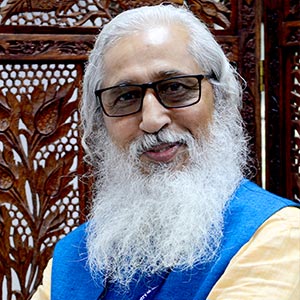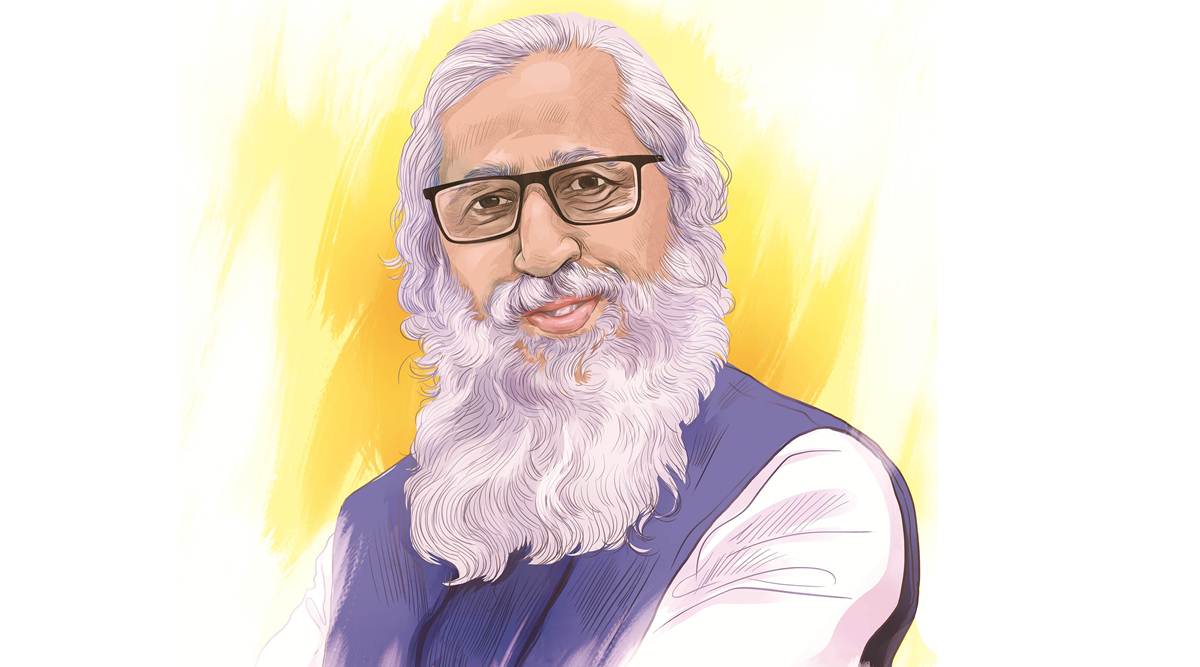AICTE CHAIRMAN ANIL SAHASRABUDHE, THOUGHT CHANGE
THE ECONOMIC SYSTEM CAN’T RUN SOLELY ON PC SCIENCE OR ELECTRONICS, IT REQUIRES CIVIL AND MECHANICAL ENGINEERING, TOO
Under his leadership, the AICTE has helmed initiatives such as the Smart India Hackathon — where engineering students create industry-ready solutions — scholarship schemes to bring girls into STEM disciplines, IDEA labs and AI tools for regional languages.

AICTE chairman Anil Sahasrabudhe on why civil and mechanical engineering courses need to incorporate AI and a start-up/entrepreneurial spirit, and how industry involvement and curriculum upgrade are key to students’ employability. The session was moderated by Assistant Editor Alifiya Khan.
Alifiya Khan: For a previous couple of years, mechanical and civil engineering appear to have taken a beating. The admission could be very low with a number of faculties closing down. There are allegations that the syllabus is outdated. Is that why college students should not taking admissions or getting jobs?
We’ve additionally been debating this difficulty internally and with the committee headed by BVR Mohan Reddy, who was chairman of the Board of Governors of IIT Hyderabad and government chairman of Cyient Ltd. We now have noticed that since there may be numerous jobs within the area of pc science and IT, most college students gravitate in the direction of these branches. Nevertheless, we want folks in different branches.
The Reddy-helmed committee has really useful to not begin any new programmes in civil, mechanical and electrical programs but additionally to not permit them to shut down fully. So, we’ve been permitting solely a 50 per cent discount in seats in them. However together with these branches of engineering, we’re advocating that college students must be allowed to take elective programs or minor diploma programmes in rising areas of know-how like Synthetic Intelligence (AI), Web of Issues (IoT), Machine Studying (ML), robotics, 3D printing, blockchain, augmented actuality (AR) and digital actuality (VR), in order that their employability grows.
And they’re additionally required as a result of the entire construction of the economic system can’t run solely on pc science or electronics. So, whereas I agree there have been fewer college students taking admissions, we’re motivating them; there’s a requirement for these branches.
Alifiya Khan: On the allegations that the syllabus is just not up to date according to the instances or {industry} calls for, are you contemplating any main revisions?
I don’t agree with this. We’ve been always revising and offering a mannequin curriculum for universities to undertake. Now, I do agree that some universities haven’t adopted it, however 4 years in the past, we consulted folks from the {industry}, IITs, and a number of the nation’s greatest establishments for every self-discipline. This manner we modified the curriculum. In some domains, modifications occur regularly. Some programs might solely must be added as electives. However in mechanical, electronics and pc science, the place the trajectory of change is quick, we will’t await lengthy. We now have undertaken a large train to replace their curricula this yr.
Partha Biswas: How are you inculcating the start-up tradition and the entrepreneurial spirit within the four-year engineering diploma programme? For one thing as core as civil engineering, how do you make it start-up pleasant?
We now have a course on entrepreneurship improvement (from an revolutionary concept, product improvement to mentorship). College students from any self-discipline can take this course as an elective and get first-hand expertise. Some establishments have made it necessary. The AICTE and Ministry of Schooling’s Startup Innovation Coverage have additionally permitted a pupil to take a break from research, for a yr throughout the four-year interval, to check out an concept. If profitable, you might proceed on a part-time foundation. If not, you possibly can return and full your research. This provision by no means existed. We even have the Ministry’s Innovation Cell in AICTE and have gotten greater than 3,200 innovation councils in faculties. We now have already run 4 Sensible India Hackathons.
Neeti Nigam: Are there fewer jobs for engineering college students in India? Is that why they migrate to e-commerce for higher wage packages?
You’re partly right. The variety of jobs within the hardcore mechanical {industry} goes to be restricted due to automation in these industries. However these with entry to AI and ML will discover helpful jobs in these industries as effectively. It’s essential to organize them not solely within the core self-discipline but additionally equip them with add-ons.
Neeti Nigam: A number of mechanical engineering college students complain that in nations just like the US and the UK, locals get the ‘cream jobs’, not Indians. With the shortage of proper affords, in India or overseas, college students are selecting streams apart from mechanical and chemical.
A few of them may begin their very own start-ups. I’m repeatedly saying, why ought to they rely on jobs overseas? The federal government is supporting not simply startups but additionally Make in India. Take the defence sector that may require mechanical, civil, electrical and chemical engineering graduates. Why can’t we manufacture gear right here and create native jobs? Until we reorient ourselves, our curriculum, and coaching, we gained’t be self-reliant, not solely in defence however in lots of different sectors as effectively.
Anuradha Mascarenhas: There is a want to coach school. What is being finished within the school improvement programme?
AICTE, within the final 4 years, began creating eight necessary modules for brand spanking new lecturers. We’ve developed a full vary of programs and every certainly one of them is the same as practically three credit or one semester. Younger lecturers, until they full eight modules, won’t get regularised.
The right way to create lesson plans? The right way to make use of recent know-how, not solely the web but additionally AI, VR and ML? The right way to embed them in a classroom? The right way to interact college students who be taught first-hand from the web and are available ready to class? Our examination system has been based mostly on rote-learning. We’re by no means requested questions that take a look at our understanding of the topic, vital pondering, analytical capability, information analytics and creativity. Your complete problem-solving capability, innovation, creativity, and, in flip, start-ups, have been fewer. Our teacher-training modules handle all these features.
Ritika Chopra: As a part of the scheme to supply engineering programmes in regional languages, 19 faculties signed up final yr from an preliminary 14. After we have a look at the enrolment information, 9 or 10 of them haven’t managed to fill even a single seat. How come?
We began final yr, so naturally only a few folks have been conscious of it. We now have to create extra consciousness. This yr, 10 extra faculties have joined. As we speak, about 29 faculties have requested for added seats for the programme. Faculties in lots of states have began providing programs of their mom tongue. The circulars from the Madhya Pradesh and Bihar governments listing 10 faculties the place establishments working programmes in English have been requested to conduct them in Hindi.
The provision of textbooks in these languages was a really vital step. Our first goal was to begin publishing books in six languages for first-year college students. Now, we’re on to second-year books and increasing translated books to 12 languages. Extra takers will are available a few years. Second, engineering college students mostlypursue instruction in English. Until these programs are performed in regional languages on the native stage, there will likely be fewer college students choosing highereducation. There’s a push for it in therural areas.

Alifiya Khan: During the last two years, lots of people have been pursuing administration levels on-line. Reputed AICTE-approved institutes and ed-tech corporations are providing these. Are their requirements and content material being vetted?
First, each the AICTE and UGC have despatched out circulars and commercials that ed-tech corporations have their very own position in offering inputs for on-line schooling, whereas accredited establishments have a significant position, and that distinction has been made very clear. It’s the instructional establishment which has to determine the curriculum, content material, and the supply of the course. However the nature of supply, how it may be made extra fascinating in an internet platform vis-à-vis the classroom is the place the ed-tech corporations are available. Not each establishment could possibly develop a strong learning-management system or a web site to offer this help by making use of newer applied sciences equivalent to AI, VR, and ML. Ed-tech corporations play an enormous position in embedding these applied sciences within the studying course of.
Ritu Sharma: For the final seven years, greater than 50 per cent of the seats in non-public institutes have been vacant. Regardless of the large mismatch between demand and provide, why are new non-public institutes being accredited and opened yearly?
For the final three years, we’ve not allowed any new engineering school to be arrange by any non-public establishment. As I stated, the Prof. Reddy Committee categorically acknowledged that no new engineering school must be arrange besides in deprived districts. These have been earlier known as backward districts, however at this time, our Prime Minister calls them aspirational districts, the place an establishment arrange by the state authorities would attain out to unserved college students.
That’s why we allowed solely such faculties. This yr, two extra varieties of instructional establishments have been allowed. One is the industry-backed instructional programme, which can naturally be of top of the range. One other is about 50 or 100-year-old establishments, which do not need an engineering programme however have greater than 10,000 college students in otherprogrammes. In the event that they wish to change into a multidisciplinary establishment oruniversity, engineering is without doubt one of the essential domains.
Sheetal Banchariya: We’ve been listening to rather a lot about Atmanirbhar Bharat and startups. However in response to the IBM Institute and Oxford Economics analysis, greater than 90 per of cent Indian start-ups fail. So, they don’t actually seem like a viable possibility however simply one other burden. Are we shying away from the truth that there are fewer alternatives for start-ups to flourish?
There isn’t any nation on the planet the place greater than 5 to 6 per cent of the startups absolutely succeed. Lots of them both shut down or promote out to larger corporations. Most nations have comparable percentages, so don’t go by that. Second, regardless of the financial downturn throughout the two pandemic years, the variety of unicorns from India has been staggering. We had 42 unicorns final yr. This yr, start-ups, whether or not within the well being, ed-tech or agricultural sectors, have already kickstarted their run.
Sourav Roy Barman: The current Nationwide Achievement Survey report confirmed how studying ranges have taken successful throughout the pandemic as a consequence of lengthy faculty closures and the digital hole. Your personal report reveals that even in engineering schooling, there are studying gaps, notably amongst first-year college students, particularly in arithmetic. Will the AICTE instruct all technical institutes to undergo the Parakh findings and take corrective motion?
We would like further materials to be offered to those (engineering) college students, perhaps further lessons within the night/weekends, in any other case the educational within the subsequent yr may also get affected. Many states have their very own programmes on the faculty stage. We now have developed our portal Vidyanjali together with Parakh the place volunteerism will likely be advocated. Any particular person, who’s an professional in a specific topic, may help lecturers at a close-by faculty/school and increase sources to impart classes. It may even be within the type of psychological help. A number of folks have come on board. Such a system will assist bridge the hole in six months to a yr.
Alifiya Khan: There’s an enormous proportion of Indian college students at Ivy League universities or higher-education establishments overseas who’re pursuing analysis or PG programs in ME and MTech. Why don’t they do the identical right here? How will AICTE change the narrative?
AICTE, the Ministries of Schooling and Exterior Affairs have been speaking a few ‘Research in India’ programme to not solely cease mind drain but additionally to draw international college students. Until that educational tradition is created, it’s not very straightforward to carry on to expertise. That’s why all these initiatives, when it comes to constructing help techniques, will assist in an enormous approach. When our establishments begin figuring in world rankings, that includes within the prime 200-300 bracket and slowly inching in the direction of the best-100 membership, then they might mechanically get traction.
The brand new Nationwide Schooling Coverage 2020 (NEP) is advocating that a number of the greatest universities arrange campuses in India itself. So there’s a competitors and likewise collaboration which can occur between Indian and international universities. Then, perhaps, fewer college students will go overseas. They are going to begin learning right here and get international levels at their doorstep at a decrease expenditure. As we speak, if 10 college students migrate overseas, just one pupil returns. How can this ratio be reversed? It is going to require plenty of effort.
Alifiya Khan: We rejoice when Indian universities seem within the 500-600 rank class of the QS World College and Instances Larger Schooling rankings. The very fact is, we have to do significantly better…
First, most of the parameters the rating companies contemplate should not beneficial to us in any respect. For instance, they speak about variety, which quantifies the variety of international school and college students in that establishment. Have a look at the variety in a lot of our Indian establishments. We now have college students from 28-odd states and 6 Union territories, with completely different languages and cultures. Is that not variety?
We even have reservations to allow college students from Scheduled Castes and Tribes in addition to these with disabilities. The variety of lady college students is rising. Third, there’s an enormous notion rating that’s based mostly on non-transparent processes. I believe there are numerous imponderables, that are occurring on the planet rankings. So we shouldn’t be too apprehensive about the place we stand, however we’ve been doing fairly effectively. In case you take one essential parameter, analysis, which is instantly seen, our Indian Institute of Science (IISc, Bengaluru) is No.1 on the planet when it comes to quotation. IIT Guwahati, a relatively new establishment, additionally stood very effectively on that rely. By way of innovation, we have been on the 81st place nearly 5 years in the past. As we speak, in innovation rankings, we’re forty sixth.
Pallavi Sensible: The analysis work within the engineering sector is restricted to the Institutes of Eminence. Is the AICTE doing one thing to encourage analysis in particular person affiliated engineering faculties as effectively?
Innovation and analysis go hand in hand. Not too long ago, I went by the Internet of Science and your complete evaluation of the analysis publications from India from three years in the past till now. We now have been always bettering our contribution to the world of analysis. Out of the overall analysis output in India, about 24 per cent comes from top-tier establishments like NITs and IITs, 23 per cent comes from our labs — authorities companies, non-academic/college analysis labs, and the remaining 53 per cent comes from strange faculties and universities, together with AICTE-approved faculties.

